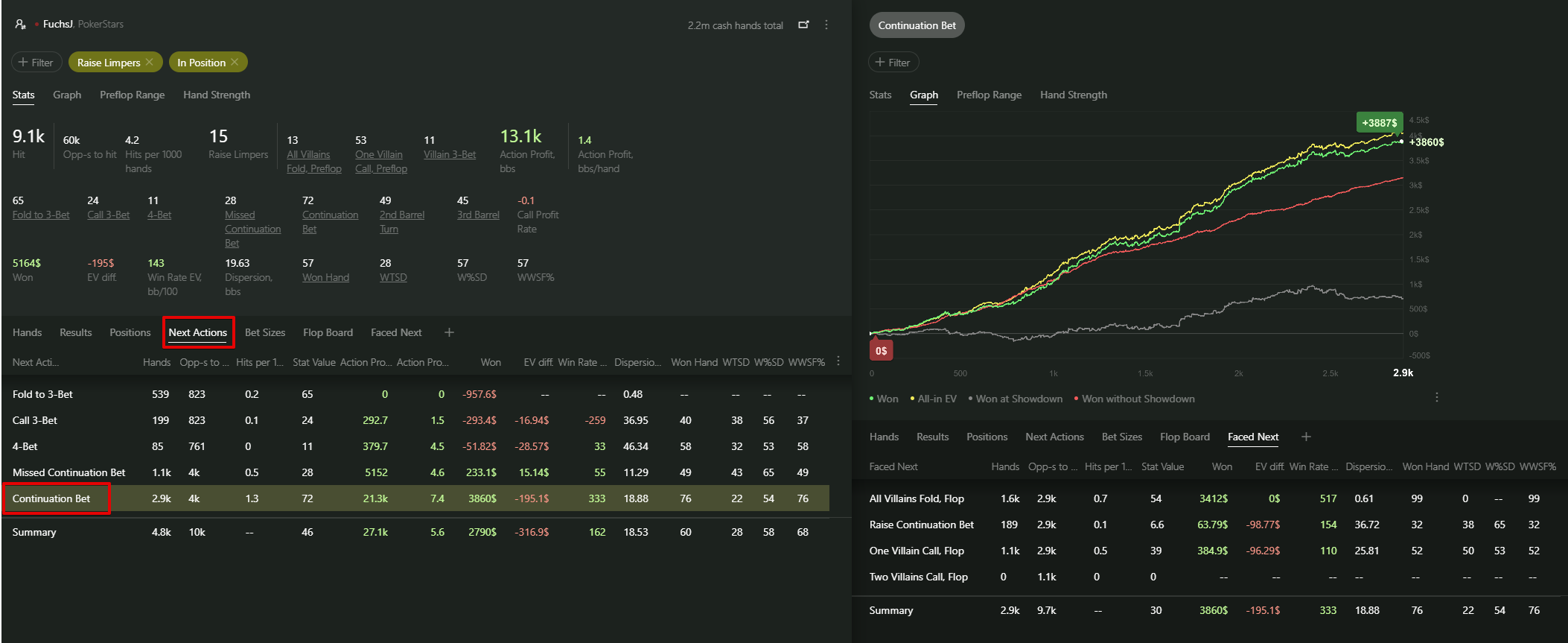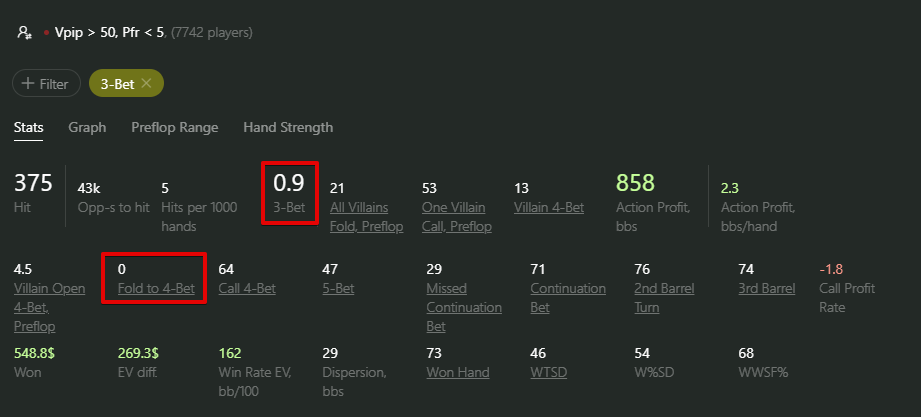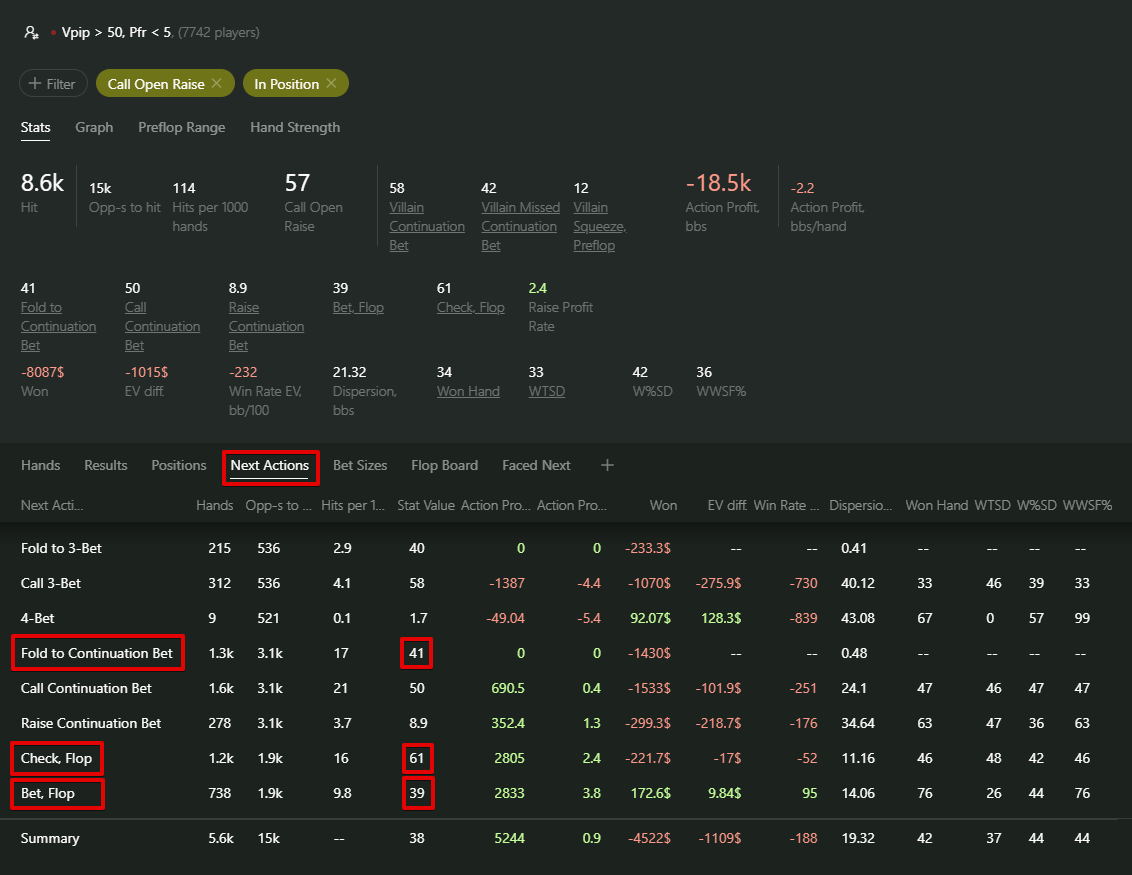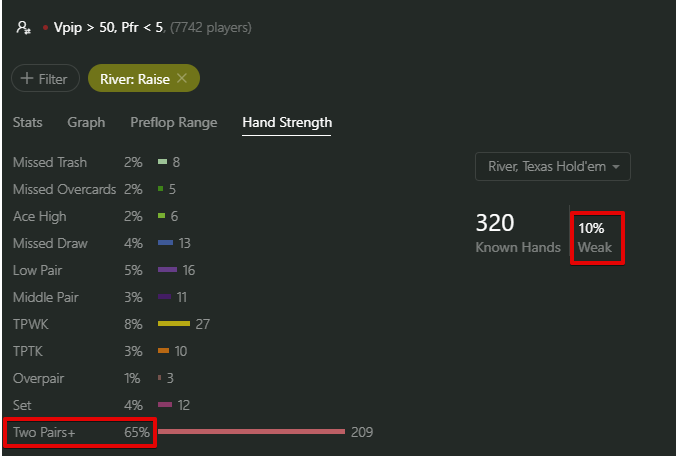5 exploitative strategies against passive fish
Passive fish are recreational players who primarily prefer a cautious approach, frequently calling bets and rarely showing aggression.
In this article, we will explore 5 strategies that will help you maximize your advantage when playing against such opponents.
Table of Contents
Isolate them with a wide range
Bet yourself with a strong hand, don’t plan check-raises
Adjust the size of your river bets
Be attentive to their river raises
# Isolate them with a wide range
Passive fish often limp preflop, attempting to see the flop with minimal investment almost regardless of their hand. After missing the flop, many of them play straightforwardly, offering little resistance without a decent hand.
When in position against such an opponent, your goal should be to play as many hands as possible with them and isolate them from other players by raising with a wide range.
Your strategy is to stay heads-up with such a player on the flop and take down the pot with a continuation bet.
Let’s check the effectiveness of this strategy in Hand2Note 4 reports:

Utilizing filters, I pinpointed scenarios where I isolated limpers while holding a positional advantage. Then, by going to the “Next Actions” report, I moved to the spot when I made a continuation bet on the flop.
The graph on the right indicates that, in this situation, my profit primarily arises from winning without reaching a showdown, represented by the red line. This is due to the frequent folds of passive opponents to continuation bets when they play out of position.
# Trust their 3-bets
Passive fish rarely open with a raise preflop, opting to do so only with strong hands. Can you imagine what their 3-bet range would be like then?
Let’s determine it using multi-player reports in Hand2Note 4. This innovative feature allows you to identify patterns in the game of opponents who play in a similar style and build exploitative strategies against them.

For the report, I selected all passive fish in my database, setting the parameters VPIP over 50% and PFR less than 5%. Then, I filtered situations where such players made a 3-bet preflop. As shown in the screenshot above, their 3-bet frequency is less than 1%, indicating an extremely narrow and strong range.
Be cautious when facing a 3-bet from a passive opponent. Firstly, you should avoid continuing with hands like AJ, AT, or KQ, which might seem decent at first glance.
The problem with such hands is that they will often be dominated by the 3-bet range of the fish, primarily composed of hands like AA, KK, QQ, and AK.
Secondly, we see that after making a 3-bet, passive fish never fold to a 4-bet. This can be explained by the strength of their range. Therefore, it’s crucial for you to completely refrain from bluffing with 4-bets to avoid giving away money to such players.
# Bet yourself with a strong hand, don’t plan check-raises
You already know that when out of position and playing against aggressive fish, it is very profitable to check-raise strong hands on the flop. Against passive opponents, on the contrary, it is better for you to bet yourself. To confirm this, let’s analyze the tendencies of passive fish on the flop:

In smart reports of Hand2Note 4, all relevant information is always at your fingertips. Using filters, I simulated a scenario where passive fish called an open raise preflop while playing in position.
Opening the Next Actions report, we can notice that the frequency with which these players fold to a continuation bet on the flop is 41%.
At the same time, facing a check on the flop, such opponents bet 39% of the time and check back 61% of the time.
Based on these statistics, we can conclude that passive fish frequently call continuation bets on the flop but seldom respond aggressively to a check. Planning a check-raise with a strong hand against a passive opponent, you risk missing a street of value. Therefore, if you have a strong hand on the flop, just continue betting.
# Adjust the size of your river bets
Not all passive fish fold on the early streets without a strong hand. Some will call your bets all the way to the river, trying to improve their hand or thinking that you are bluffing. As a result, on the river, their range will still include some weak and medium-strength hands.
With a strong hand, your goal is to extract value from your opponent, and with a weak hand, you aim to force them to fold. Depending on the goal you pursue, you should choose an appropriate bet size.
Let’s examine how passive fish react to different bet sizes on the river:

Thanks to the convenient reports navigation in Hand2Note 4, you can easily and quickly move between related situations. Applying filters, I selected a scenario where passive fish called an open raise preflop and then also called continuation bets on the flop and turn.
As revealed in the “Next Actions” report, they fold reluctantly on the third barrel, only in 37% of cases. Let’s take a closer look at this situation.
After clicking on the “Fold to 3rd Barrel” stat, a new report appears on the right. Going to the “Bet Sizes” tab in that report, we note the following pattern: the majority of the time, precisely in 60% of instances, these players fold to an overbet, whereas they exhibit a folding frequency ranging from 31% to 38% for bets smaller than the pot.
Thus, against such opponents on the river, it is profitable to bluff with overbets, while for value betting, you should employ bets that do not exceed the size of the pot.
# Be attentive to their river raises
If passive fish ever try to bluff, it certainly won’t be with a river raise. This is a very strong move, and as we already know, a strong action from a passive player typically indicates a very strong hand.
Let’s examine their river raising range:

In the report, I specifically chose instances where passive fish made a raise on the river. In the “Hand Strength” tab, we can analyze the percentage distribution of combinations associated with this action.
As we can observe, combinations from two pairs and stronger constitute 65% of their range, while weak hand only make up 10%.
Therefore, when making a bet on the river and facing a raise from a passive fish, bear in mind that, typically, they hold a strong hand, and you should not attempt bluff-catching them.
To succeed in poker, it’s crucial not only to understand your opponents’ playing style but also to effectively analyze their statistics. By using Hand2Note 4, you can easily identify the tendencies of passive fish, exploit their weaknesses, and make optimal decisions to maximize your profits.
# 5 exploitative strategies against passive fish
Passive fish are recreational players who primarily prefer a cautious approach, frequently calling bets and rarely showing aggression.
In this article, we will explore 5 strategies that will help you maximize your advantage when playing against such opponents.
Table of Contents
Isolate them with a wide range
Bet yourself with a strong hand, don’t plan check-raises
Adjust the size of your river bets
Be attentive to their river raises
# Isolate them with a wide range
Passive fish often limp preflop, attempting to see the flop with minimal investment almost regardless of their hand. After missing the flop, many of them play straightforwardly, offering little resistance without a decent hand.
When in position against such an opponent, your goal should be to play as many hands as possible with them and isolate them from other players by raising with a wide range.
Your strategy is to stay heads-up with such a player on the flop and take down the pot with a continuation bet.
Let’s check the effectiveness of this strategy in Hand2Note 4 reports:

Utilizing filters, I pinpointed scenarios where I isolated limpers while holding a positional advantage. Then, by going to the “Next Actions” report, I moved to the spot when I made a continuation bet on the flop.
The graph on the right indicates that, in this situation, my profit primarily arises from winning without reaching a showdown, represented by the red line. This is due to the frequent folds of passive opponents to continuation bets when they play out of position.
# Trust their 3-bets
Passive fish rarely open with a raise preflop, opting to do so only with strong hands. Can you imagine what their 3-bet range would be like then?
Let’s determine it using multi-player reports in Hand2Note 4. This innovative feature allows you to identify patterns in the game of opponents who play in a similar style and build exploitative strategies against them.

For the report, I selected all passive fish in my database, setting the parameters VPIP over 50% and PFR less than 5%. Then, I filtered situations where such players made a 3-bet preflop. As shown in the screenshot above, their 3-bet frequency is less than 1%, indicating an extremely narrow and strong range.
Be cautious when facing a 3-bet from a passive opponent. Firstly, you should avoid continuing with hands like AJ, AT, or KQ, which might seem decent at first glance.
The problem with such hands is that they will often be dominated by the 3-bet range of the fish, primarily composed of hands like AA, KK, QQ, and AK.
Secondly, we see that after making a 3-bet, passive fish never fold to a 4-bet. This can be explained by the strength of their range. Therefore, it’s crucial for you to completely refrain from bluffing with 4-bets to avoid giving away money to such players.
# Bet yourself with a strong hand, don’t plan check-raises
You already know that when out of position and playing against aggressive fish, it is very profitable to check-raise strong hands on the flop. Against passive opponents, on the contrary, it is better for you to bet yourself. To confirm this, let’s analyze the tendencies of passive fish on the flop:

In smart reports of Hand2Note 4, all relevant information is always at your fingertips. Using filters, I simulated a scenario where passive fish called an open raise preflop while playing in position.
Opening the Next Actions report, we can notice that the frequency with which these players fold to a continuation bet on the flop is 41%.
At the same time, facing a check on the flop, such opponents bet 39% of the time and check back 61% of the time.
Based on these statistics, we can conclude that passive fish frequently call continuation bets on the flop but seldom respond aggressively to a check. Planning a check-raise with a strong hand against a passive opponent, you risk missing a street of value. Therefore, if you have a strong hand on the flop, just continue betting.
# Adjust the size of your river bets
Not all passive fish fold on the early streets without a strong hand. Some will call your bets all the way to the river, trying to improve their hand or thinking that you are bluffing. As a result, on the river, their range will still include some weak and medium-strength hands.
With a strong hand, your goal is to extract value from your opponent, and with a weak hand, you aim to force them to fold. Depending on the goal you pursue, you should choose an appropriate bet size.
Let’s examine how passive fish react to different bet sizes on the river:

Thanks to the convenient reports navigation in Hand2Note 4, you can easily and quickly move between related situations. Applying filters, I selected a scenario where passive fish called an open raise preflop and then also called continuation bets on the flop and turn.
As revealed in the “Next Actions” report, they fold reluctantly on the third barrel, only in 37% of cases. Let’s take a closer look at this situation.
After clicking on the “Fold to 3rd Barrel” stat, a new report appears on the right. Going to the “Bet Sizes” tab in that report, we note the following pattern: the majority of the time, precisely in 60% of instances, these players fold to an overbet, whereas they exhibit a folding frequency ranging from 31% to 38% for bets smaller than the pot.
Thus, against such opponents on the river, it is profitable to bluff with overbets, while for value betting, you should employ bets that do not exceed the size of the pot.
# Be attentive to their river raises
If passive fish ever try to bluff, it certainly won’t be with a river raise. This is a very strong move, and as we already know, a strong action from a passive player typically indicates a very strong hand.
Let’s examine their river raising range:

In the report, I specifically chose instances where passive fish made a raise on the river. In the “Hand Strength” tab, we can analyze the percentage distribution of combinations associated with this action.
As we can observe, combinations from two pairs and stronger constitute 65% of their range, while weak hand only make up 10%.
Therefore, when making a bet on the river and facing a raise from a passive fish, bear in mind that, typically, they hold a strong hand, and you should not attempt bluff-catching them.
To succeed in poker, it’s crucial not only to understand your opponents’ playing style but also to effectively analyze their statistics. By using Hand2Note 4, you can easily identify the tendencies of passive fish, exploit their weaknesses, and make optimal decisions to maximize your profits.















